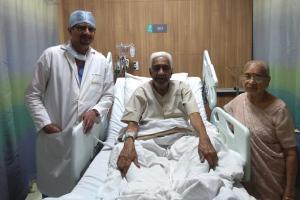Hemraj Haria, a Wadala resident, had a mild abdominal pain when he came to the hospital

An 87-year-old Mumbaikar, diagnosed to have thoracic and abdominal aortic aneurysm, was treated by a unique procedure at Sir HN Reliance Foundation Hospital.
ADVERTISEMENT
Hemraj Haria, a Wadala resident, had a mild abdominal pain when he came to the hospital. He was diagnosed to have an aortic aneurysm- a large dilation of both abdominal and thoracic aorta.
According to doctors, he needed an immediate intervention as leaving alone, it would have ruptured any time or would have produced a serious complication.
"The aneurysm of the thoracic aorta was more than double the normal size," said Dr Bipeenchandra Bhamre, Cardiovascular surgeon, under whom Haria got admitted.
Given Haria's age, it was decided to treat the aneurysms, by a minimally invasive procedure endovascular aortic stent grafting. "While the traditional method to treat aortic aneurysms is an open bypass surgery, nowadays endovascular aortic stent grafting reduces the risk of open surgery, such as prolonged general anaesthesia, bleeding and infection. It is an advanced and minimally invasive technique where a special graft is deployed at the site of an aneurysm by catheter technique avoiding open surgery," said Dr Rahul Sheth, endovascular aortic specialist, Sir HN Reliance Foundation Hospital.
The doctors, however, faced a hurdle as endovascular aortic stent grafting requires usage of contrast agents to visualise the blood vessels. "During the investigations, we found that his kidney functions were slightly elevated. Using contrast agents can further damage the kidneys," said Dr Sheth.
Doctors then brainstormed and decided to go for Intra-vascular ultrasound guided aortic stent graft for Mr. Haria.
"We opted for Intra-vascular ultrasound imaging to help us image the vessels to properly position the graft. This reduces the need for contrast agents, helping to reduce the risk of kidney damage," said Dr Sheth.
This was the first procedure in Western India, where the use of ultrasound imaging of the aorta was done to help us to accurately image the normal segments and place the device in the aorta, to seal an aneurysm. This was performed in the state of the art, hybrid cath lab in Sir HN Reliance Foundation Hospital.
The procedure was done by Dr Rahul Sheth, endovascular aortic specialist and Dr Bipeenchandra Bhamre, Cardiovascular surgeon. Other team members were Dr Maunil Bhuta and Dr Hemant Mehta.
While Mr Haria was discharged from the hospital on November 28, he will undergo another procedure to treat the abdominal aortic aneurysm early next year.
 Subscribe today by clicking the link and stay updated with the latest news!" Click here!
Subscribe today by clicking the link and stay updated with the latest news!" Click here!






